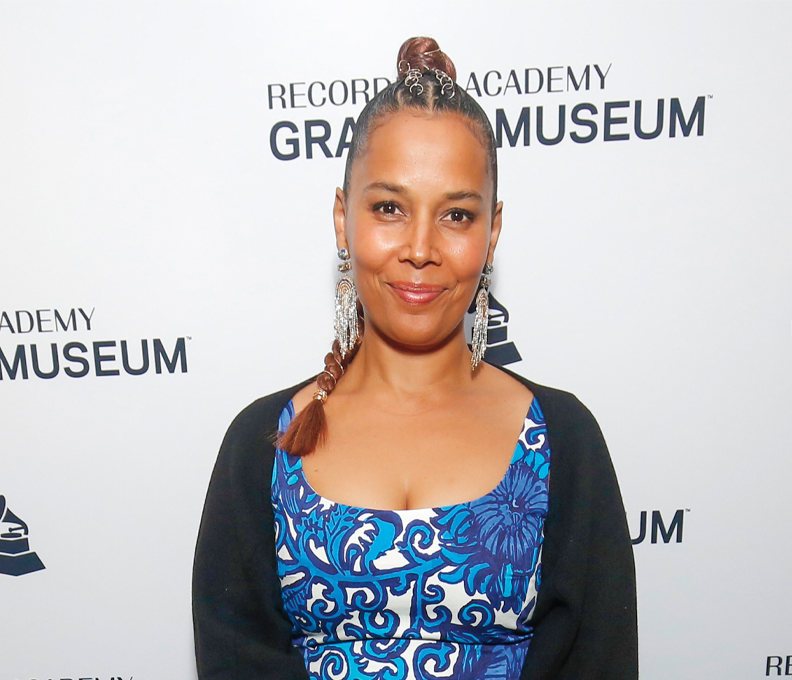After Taking Over NYC and Miami, Major Food Group Looks Beyond Fine Dining
"We’ve scratched the surface of what we’re going to do, but we still have a long way to go"
by Shivani Vora
March 31, 2023

Rich Torrisi, Jeff Zalaznick and Mario Carbone at ZZ’s Club, Miami / Photo: Courtesy of Riocam
It was a Monday night in January, an achingly slow time for restaurants as diners recovered at home from holiday revelries. But The Lobster Club, a Japanese eatery in Midtown Manhattan, was a microcosm of its own.
Here, in a dark, glamorous space designed by renowned architect Peter Marino, a well-dressed crowd gathered at the bar sipping cocktails and pours of rare Japanese whisky. More filled every table in the sleek dining room and ordered plates of sushi and other raw fish dishes presented with seafood that had arrived from Japan earlier that day.
Guests kept pouring in as the evening stretched on. Oblivious to the seasonal slump, they were here for good food and a memorable time. From their animated faces, it was clear that both were being had by all.
Welcome to just another night with Major Food Group (MFG), whose diners are never there for only a meal. A reservation heralds a full-on theatrical spectacle that engages every sense. Among today’s most successful hospitality brands, the company is on its way to becoming a global empire.
If you don’t know the name MFG, you’ve likely heard of at least one of its concepts. They are, after all, chronicled frequently in the press for their inventiveness and celebrity-studded clientele.

Capellini Cantonese at Torrisi, New York City / Photo: Courtesy of Evan Sung
Founded in 2010 by restaurateur Jeff Zalaznick and chefs Mario Carbone and Rich Torrisi, the brand is behind the Italian-American spot Carbone, with locations in New York City, Las Vegas, Hong Kong, Miami Beach, Dallas and Doha. The trio also created the brunch institution Sadelle’s, which has outposts in New York, Paris, Las Vegas, Miami, Dallas, Boca Raton and Riyadh, and The Grill and The Pool, a steak house and event space located in New York’s Seagram Building. Once home to the Four Seasons Restaurant, it’s a venue that plays a significant role in American dining history.
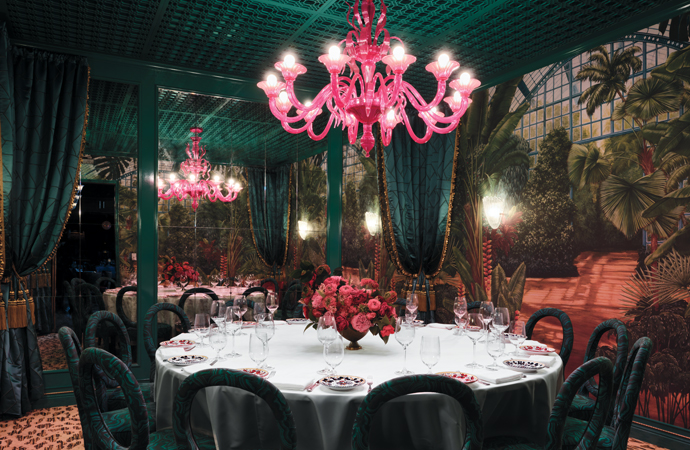
Carbone, Dallas / Photo: Courtesy of Douglas Friedman
All told, MFG has 40 establishments and counting—more than 20 of which have opened in the last two years. “We’re storytellers at our core,” Carbone tells me during an interview with the three founders at Contessa, their opulent two-story Italian eatery in Miami’s Design District. “In the same way that a writer approaches a story, or a director makes a movie, we put on a play with our restaurants. The audience is our customers.”
Speaking of stories, the one of how MFG started is now the stuff of modern dining folklore: The Westchester, New York-raised Torrisi, who had worked at French restaurants, and Carbone, who grew up in Queens and cooked at Italian spots, met while they were students at the Culinary Institute of America. Both Italian-Americans, they became fast friends and collaborated to open Torrisi Italian Specialties on New York’s Mulberry Street. By day, it sold sandwiches, and for dinner, it transformed into a fine-dining boîte.
Word spread among food cognoscenti about the excellent cuisine, and Zalaznick, an entrepreneur with an investment banking background who was always looking for the next restaurant gem, heard about it. “I walked in, ordered everything on the menu and came back again and again,” he says. “I knew that I had to be part of the magic.”
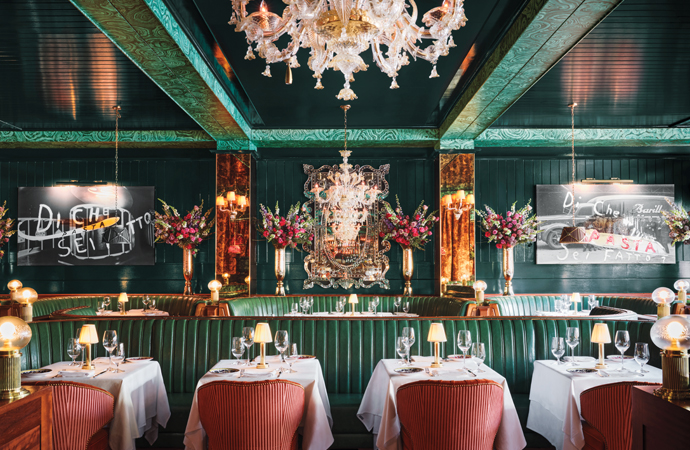
Carbone, Miami Beach, Florida / Photo: Courtesy of Douglas Friedman
Six months later, Zalaznick joined the team, and MFG was born. Their sandwich shop Parm followed in 2011, and then came Carbone. “All three of us, independent of each other, wanted to open a restaurant that paid homage to classic Italian-American cuisine. Rich and Mario had grown up with it, and I loved eating it,” recalls Zalaznick. “Carbone is the result.”
A throwback to restaurants from the 1950s, the eatery offers an experience akin to stepping back in time. Music from the era—think Frank Sinatra and doo-wop—sets the mood while bow-tied servers proffer oversized plates of shrimp scampi, Caesar salad, veal marsala and the much-talked-about spicy rigatoni vodka.
“The dishes on the menu are exactly what you would find in an upscale Italian restaurant in 1958,” says Torrisi. “We didn’t touch them, but we did make the best versions of them that we possibly could.”
He attributes MFG’s success in part to the principle of keeping food authentic. “A lot of chefs put a spin on classics, but it’s not something customers necessarily connect with,” he says. “Our view is to stick to the original, because people relate to it and feel comforted by it.” Torrisi believes this is why MFG attracts regulars who dine at the restaurants multiple times a week.
Carbone was an instant sensation, with critical acclaim and a number of high-profile diners. Reservations were and continue to be hot tickets. With their presence firmly established on the restaurant map, Zalaznick, Carbone and Torrisi continued to roll out new concepts over the next seven years, including Dirty French, offering their interpretations of classic French dishes such as duck à l’orange and trout amandine.
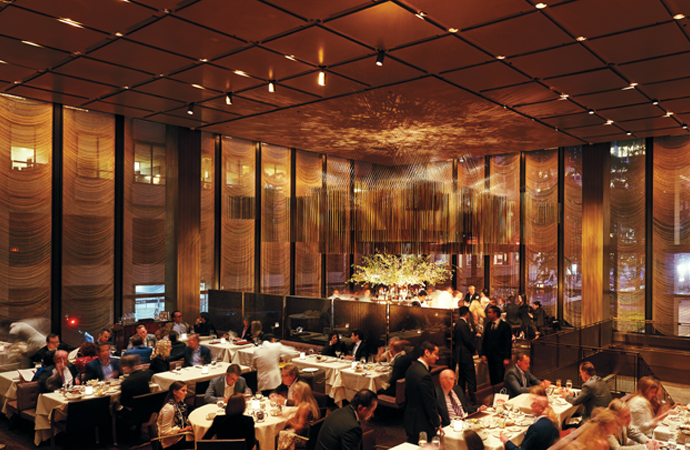
The Grill, New York City / Photo: Courtesy of Major Food Group
“Through the years, Major Food Group has made fine dining fresher, younger and trendier,” says former Eater New York editor and Houston Chronicle columnist Bao Ong. “They’ve been able to attract a new audience to the landscape. They’re a brand that the food world follows closely.”
And then came the pandemic and Miami—the catalysts that catapulted MFG into worldwide fame. In March 2020, Zalaznick was in the city staying at the Four Seasons in Surfside on a trip with his family when the world shut down. Instead of heading back to New York, he decided to stay put and hunkered down with his wife and children for the next six months. “Everything everywhere was closed, but Miami, save for a short period, wasn’t,” says Zalaznick. “I was drawn to the city’s energy but saw that quality restaurants like ours didn’t exist. The business opportunity was huge.”
Carbone came to visit and was equally attracted. “Miami made a great impression on me,” he says. “I was coming from a dead city to one that was alive and loved the idea of having a restaurant in town.”
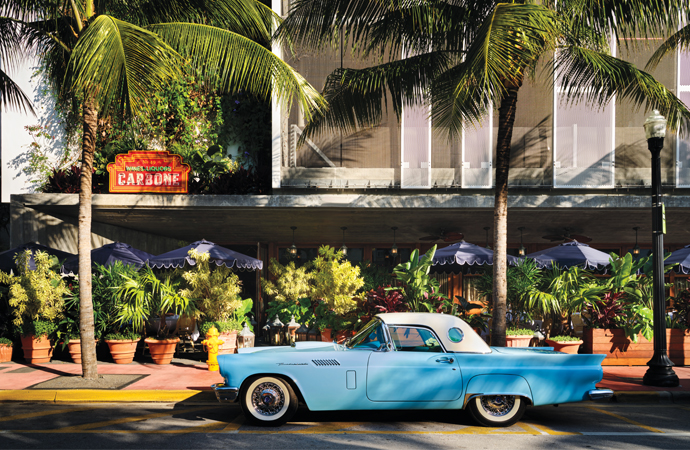
Carbone, Miami Beach / Photo: Courtesy of Douglas Friedman
Less than six months later, in January 2021, Carbone made a splashy debut in South Beach in a space featuring luscious interiors conceived by decorator Ken Fulk. Zalaznick’s instincts were spot-on: Customers swarmed in, and the red-sauce joint became the hub for Miami’s see-and-be-seen social set. “It was like New Year’s Eve every night,” recalls Carbone. “In the midst of an awful pandemic when the world was dark, we were able to make people happy.” Even today, the fever pitch for a reservation here hasn’t waned.
Carbone and Zalaznick moved to Miami full-time while Torrisi held the fort in New York. “I love Miami, but New York will always be home,” he says.
Following South Beach, the three set their sights on the Design District, an area that appealed to them for its pedestrian-friendly streets. Their footprint here includes Contessa and ZZ’s Club, which has an invite-only membership.
In addition, Sadelle’s now has an outpost in Coconut Grove, and there’s a Dirty French Steakhouse in Brickell. MFG has also expanded in Florida with four restaurants at The Boca Raton, a resort that recently completed a $200 million renovation. The list includes a mid-century chophouse, The Flamingo Grill, and Principessa Ristorante, inspired by Lake Como’s grand villas and resorts. Zalaznick vacationed at the property as a child, and it has a special place in his memories, he says. “It’s wild to me that we have the same amount of restaurants in Florida as we do in New York, where we got our start.”
“I agree,” Torrisi chimes in. “Covid shut a lot of businesses down, unfortunately, but it paved the way to push us forward and help us grow.”
MFG also had a notable pandemic-related debut with Contessa on the rooftop of The Newbury hotel in Boston, a landmark property that originally opened as The Ritz-Carlton in 1927. “We’re obsessed with history and love taking on projects with a past or bringing the past into something new we create,” says Torrisi. Contessa is now one of the busiest restaurants in the city, seating between 700 and 1,000 diners a day.
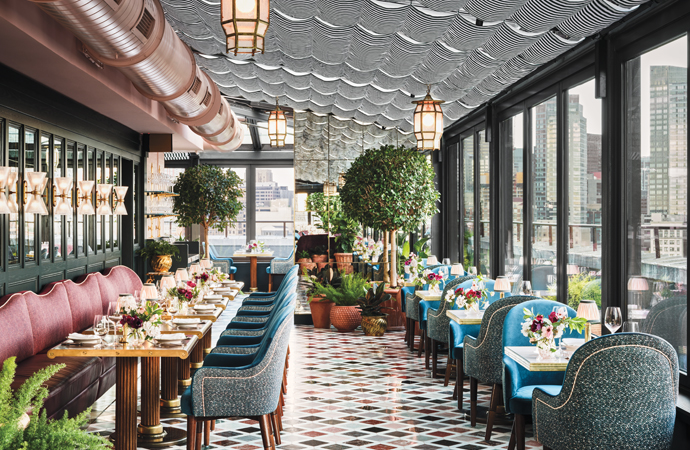
Contessa, Boston / Photo: Courtesy of Ken Fulk
Zalaznick, Carbone and Torrisi stress that they haven’t abandoned New York. The original Torrisi closed in 2015 but was resurrected in December in the historic Puck Building Downtown. As expected, it became a highly sought-after reservation from the day it opened, and recently received a rave from New York Times critic Pete Wells. “I’m in the kitchen there cooking every night,” says Torrisi. “It’s what I love most.”
This year will also see an outpost of ZZ’s Club in Hudson Yards. Spanning 30,000 square feet, the venue will feature a Japanese spot, a members-only Carbone, three bars and two lounges. Global openings include a Carbone in Riyadh.
The trio tells me that they have ambitions beyond restaurants. “We’re interested in hospitality overall,” says Zalaznick. “We’re looking at creating branded residences in collaboration with a developer and also hotels. We would bring the same approach to living that we do with restaurants. The quality is top-of-the-line, the amenities are second to none, and the design is a feature.”
He pauses and adds, “Let’s just say that we’ve scratched the surface of what we’re going to do, but we still have a long way to go.” They’re already stars with their first non-restaurant venture—a line of Carbone pasta sauces that launched in 2021. “We wanted to produce a product that could reach everyone, and for us, pasta sauce was obvious,” says Carbone. The line of six sauces, including tomato basil and roasted garlic, fast became a phenomenon. Available at close to 20,000 stores, they’re on track to sell seven million jars this year. “The explosive growth of the sauces has well exceeded our expectations,” says Carbone.

Sweet and sour sardines at Torrisi / Photo: Courtesy of Evan Sung
Even though they’re no longer all living in the same city, Zalaznick, Torrisi and Carbone speak daily and work together with an easy rhythm. Torrisi spends the bulk of his time in the kitchen at his namesake restaurant and tests all the recipes for MFG’s concepts. Carbone hops between various kitchens to oversee the cooking lines and lend tutelage while Zalaznick wears the business hat and is the taste tester for the group. Still, their roles are interchangeable, they say. “We all wear a lot of hats,” insists Zalaznick.

Fennel and grapefruit insalata at Carbone Vino, Dallas / Photo: Courtesy of Major Food Group
Business partners, yes, but Zalaznick, Carbone and Torrisi are also great friends. The day I interview them is Carbone’s 43rd birthday. Torrisi has flown in for the occasion, and they plan to celebrate over dinner that night. “We’re still trying to figure out where to go,” says Zalaznick. “The truth is that we create restaurants that we ourselves want to eat at all the time, so they’re always our go-to, but since we own them, we’re on the job whenever we’re there.”
Torrisi and Carbone nod in agreement. “What’s the point of having a business when the people behind it wouldn’t want to be patrons?” asks Carbone. “That goes against everything we believe in, and how we got to where we are today.”

